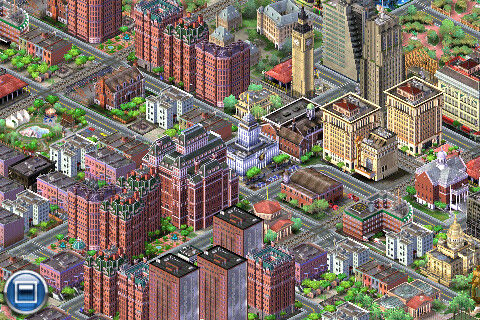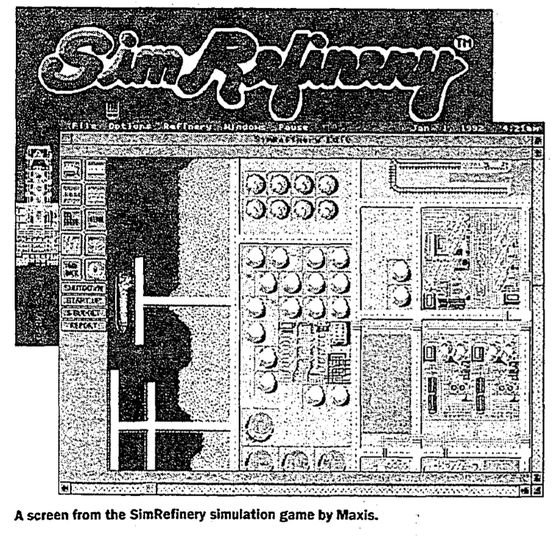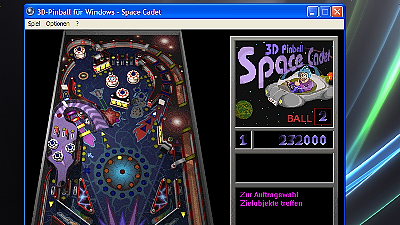What is the imaginary simulation game that was born from the success of 'SimCity'?

When SimCity got serious: the story of Maxis Business Simulations and SimRefinery | The Obscuritory
https://obscuritory.com/sim/when-simcity-got-serious/
SimCity was developed as inspired by research into actual urban planning concepts. However, Will Wright , the developer of SimCity, said in an interview, 'Because of chaos theory and a lot of other things, I realized early on that approaching simulation as a predictive attempt was hopeless. SimCity has always been an imitation of the mechanics of a city, not a model of how a city actually works.' He explained that although SimCity was inspired by urban planning, it was not created to accurately simulate it, but was created to be enjoyed as a game.
In a 1999 interview, Wright said, 'What we want to do is not make SimCity a more realistic simulator,' but many people believed they could develop a more accurate city development simulator. As a result, Wright was advised by many people to 'make a professional version of SimCity.'
As Wright said, Maxis, the developer of SimCity, did not want to develop a more sophisticated simulation game. However, from 1992 to 1994, Maxis's business simulation division developed a more professional simulator for businesses in response to customer requests. The professional simulators developed by the business simulation division were then used by companies to train their employees, and even ended up in the White House.
Most of the simulators developed by Maxis' business simulation division have not been made public. However, The Obscuritory , a game blog that covers unreleased games, has featured a simulator developed by Maxis' business simulation division that has not been revealed until now.

by
The arrival of SimCity dramatically changed people's perception of simulation games. The success of SimCity, which was released in 1989, was unexpected, and within two years of its release, it had sales of more than $5 million (about 540 million yen), causing the size of the publisher, Maxis, to triple. However, at the time, Maxis had only 32 employees, and co-founder and CEO Jeff Brown was the sole manager and financial staff.
Also, the impact that SimCity had on people's thinking about urban planning was so great that in the 1990 Democratic primary election in Providence, Rhode Island, local media tried to have mayoral candidates ' play SimCity to check their urban planning after being elected.' One of the mayoral candidates made a careless mistake on SimCity, which was said to have affected the election results. Therefore , 'SimCity worked well as a real-life simulator,' writes The Obscuritory.
Wright thought of SimCity as 'a tool to help build mental models to understand parts of the real world,' so it seems that it was Wright's intention that it was accepted as a real-world simulator. Following the success of SimCity, Maxis developed ' SimAnt ,' a game that simulates the ecosystem of ants. Maxis developed simulation games like SimCity and SimAnt not to teach in detail about urban planning or the ecosystem of ants, but to help people understand how various systems interact through simulation.

However, many people did not understand the nuance and took it to mean that 'Maxis can build a simulator that can accurately simulate the real world.' As a result, Maxis and Wright were asked by many people, 'Why don't you develop a professional version of SimCity?' In an interview with WIRED , Wright said, 'In the first few months after the launch of SimCity, we were approached by many companies saying, 'SimCity is amazing! If we can achieve such a simulation in the city, we would like you to make Sim Pizza Hut or some kind of simulator.' We thought that such a simulation game was strange, so we refused the offer, but we still continue to receive such offers.'
In addition, Wright said, 'At one point, we got too many offers, so we decided to actually try out the idea,' revealing that he started developing a simulation game for companies that he had initially rejected.
Maxis has acquired Delta Logic, a company that develops simulation games for businesses, with funding. Maxis has made Delta Logic its new division, the Business Simulation Division, and Delta Logic's John Hiles has been appointed vice president and general manager.

by
The first project developed by Maxis' business simulation division, led by Mr. Hiles, was 'SimRefinery,' which simulates an oil refinery. SimRefinery is a simulation game that oil-related company Chevron asked Maxis to create in order to 'teach employees the complex work inside the factory.' However, Chevron did not ask SimRefinery to be produced in order to accurately convey the work of an oil refinery to its employees, but rather it was planned to show how the work processes inside the factory function and work together.
Oil refinery operators tend to focus on one plant or one task, and as a result, many of them do not consider the impact on the plant or other plants in the plant. Chevron asked Maxis to create an oil refinery simulation game with the goal of using a simulation game like SimCity to help operators understand how the plants work together.
Chevron paid Maxis $75,000 to develop a prototype of an oil refinery simulation game, which began development before Maxis acquired Delta Logic.
In developing the oil refinery simulation game, Hiles visited Chevron's oil refinery in Richmond, where he took a tour of the refinery and met with experts who explained how the entire plant worked. Regarding the Chevron employees who helped Maxis, Hiles said, 'They were very experienced men who were patient enough to teach me everything about oil refining.' It is believed that the person who helped Maxis was Chevron staff engineer Terrell Touchstone, who is said to have sent Maxis at least the various formulas involved in the process of refining oil.

The development of SimRefinery uses the SimCity code as is, and introduces the formula obtained from the oil refinery. However, the simulation of the game is as simplified as possible, and it is merely a 'simulation to grasp the overall movement of the oil refinery', and it is not 'an accurate simulation of the operation of the oil refinery'.
SimRefinery not only allows you to change the amount of raw materials input, but also allows you to produce different grades of oil at different prices. In addition, if you save on maintenance costs and the factory goes down, production will stop for a week, the factory's overall income will decrease, and the budget for maintenance will be reduced. The goal of SimRefinery is to maximize the profitability of the oil refinery in the long term, and it is necessary to make periodic modifications to improve the factory.
SimRefinery also allows players to save data and allows people with no programming experience to easily create data for educational use. Therefore, SimRefinery works in the same way as commercial games such as SimCity and SimAnt. In addition, there are ways to ruin the game, and in the worst case scenario, if the balance of chemicals handled in the factory is disturbed, the factory will explode.

Regarding the developed SimRefinery, most of Chevron's education staff said, 'I want to use it in conjunction with traditional educational tools.' Some staff also said, 'Let's get started. Try to abuse the inputs and settings to see if you can destroy the oil refinery.' Some even used the factory explosion process for education. In fact, destroying part of the factory was perfect for understanding the flow of the entire factory, as it allowed them to check what kind of malfunctions would occur in the oil manufacturing process.
SimRefinery was officially delivered to Chevron on October 26, 1992. Chevron had its staff play SimRefinery since September, and it was reported that communication with marketing and finance staff had 'dramatically improved.' Susan Kastin, who worked in employee training at Chevron, praised the effectiveness of SimRefinery, saying, 'Just throwing away information about people is not effective. People only remember what they use. These relationships remained unclear until Chevron employees played SimRefinery.' In addition, Wright, who was critical of SimRefinery even among Maxis, was skeptical of SimRefinery at first, but eventually approved it.
Although SimRefinery was highly praised, it was never widely used within Chevron. Some media outlets even reported that SimRefinery was never used at Chevron.
Still, SimRefinery has been quietly booming in the engineering world, with Professor Karen McDonald of the Department of Chemical Engineering at the University of California, Davis reporting in 1993 that she wanted to use SimRefinery in her computer lab, and successfully using it in 1997.
SimRefinery later attracted attention within Chevron, with Chevron employees contacting Maxis to ask for an update to SimRefinery. There were also rumors that SimRefinery was being used at an unconfirmed oil refinery as of 2016.
Continued
The phantom simulation game 'SimRefinery' developed 18 years ago is now available on the Internet Archive, and can be played from the browser without installation - GIGAZINE

Related Posts:
in Free Member, Game, Posted by logu_ii






